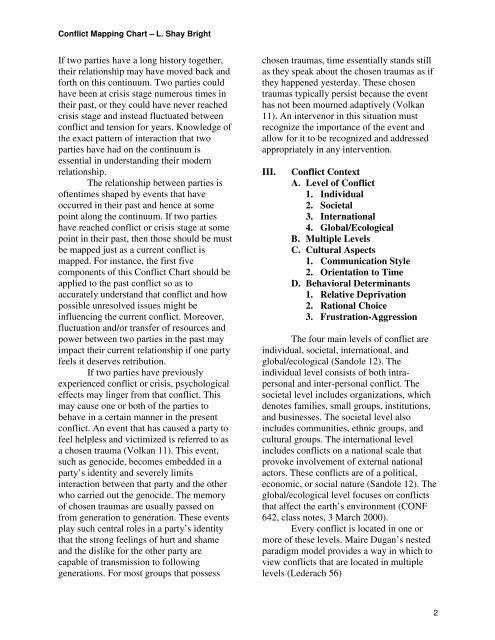The Conflict Mapping Chart By L. Shay Bright To ... - CMSupport.org
The Conflict Mapping Chart By L. Shay Bright To ... - CMSupport.org
The Conflict Mapping Chart By L. Shay Bright To ... - CMSupport.org
Create successful ePaper yourself
Turn your PDF publications into a flip-book with our unique Google optimized e-Paper software.
<strong>Conflict</strong> <strong>Mapping</strong> <strong>Chart</strong> – L. <strong>Shay</strong> <strong>Bright</strong><br />
If two parties have a long history together,<br />
their relationship may have moved back and<br />
forth on this continuum. Two parties could<br />
have been at crisis stage numerous times in<br />
their past, or they could have never reached<br />
crisis stage and instead fluctuated between<br />
conflict and tension for years. Knowledge of<br />
the exact pattern of interaction that two<br />
parties have had on the continuum is<br />
essential in understanding their modern<br />
relationship.<br />
<strong>The</strong> relationship between parties is<br />
oftentimes shaped by events that have<br />
occurred in their past and hence at some<br />
point along the continuum. If two parties<br />
have reached conflict or crisis stage at some<br />
point in their past, then those should be must<br />
be mapped just as a current conflict is<br />
mapped. For instance, the first five<br />
components of this <strong>Conflict</strong> <strong>Chart</strong> should be<br />
applied to the past conflict so as to<br />
accurately understand that conflict and how<br />
possible unresolved issues might be<br />
influencing the current conflict. Moreover,<br />
fluctuation and/or transfer of resources and<br />
power between two parties in the past may<br />
impact their current relationship if one party<br />
feels it deserves retribution.<br />
If two parties have previously<br />
experienced conflict or crisis, psychological<br />
effects may linger from that conflict. This<br />
may cause one or both of the parties to<br />
behave in a certain manner in the present<br />
conflict. An event that has caused a party to<br />
feel helpless and victimized is referred to as<br />
a chosen trauma (Volkan 11). This event,<br />
such as genocide, becomes embedded in a<br />
party’s identity and severely limits<br />
interaction between that party and the other<br />
who carried out the genocide. <strong>The</strong> memory<br />
of chosen traumas are usually passed on<br />
from generation to generation. <strong>The</strong>se events<br />
play such central roles in a party’s identity<br />
that the strong feelings of hurt and shame<br />
and the dislike for the other party are<br />
capable of transmission to following<br />
generations. For most groups that possess<br />
chosen traumas, time essentially stands still<br />
as they speak about the chosen traumas as if<br />
they happened yesterday. <strong>The</strong>se chosen<br />
traumas typically persist because the event<br />
has not been mourned adaptively (Volkan<br />
11). An intervenor in this situation must<br />
recognize the importance of the event and<br />
allow for it to be recognized and addressed<br />
appropriately in any intervention.<br />
III. <strong>Conflict</strong> Context<br />
A. Level of <strong>Conflict</strong><br />
1. Individual<br />
2. Societal<br />
3. International<br />
4. Global/Ecological<br />
B. Multiple Levels<br />
C. Cultural Aspects<br />
1. Communication Style<br />
2. Orientation to Time<br />
D. Behavioral Determinants<br />
1. Relative Deprivation<br />
2. Rational Choice<br />
3. Frustration-Aggression<br />
<strong>The</strong> four main levels of conflict are<br />
individual, societal, international, and<br />
global/ecological (Sandole 12). <strong>The</strong><br />
individual level consists of both intrapersonal<br />
and inter-personal conflict. <strong>The</strong><br />
societal level includes <strong>org</strong>anizations, which<br />
denotes families, small groups, institutions,<br />
and businesses. <strong>The</strong> societal level also<br />
includes communities, ethnic groups, and<br />
cultural groups. <strong>The</strong> international level<br />
includes conflicts on a national scale that<br />
provoke involvement of external national<br />
actors. <strong>The</strong>se conflicts are of a political,<br />
economic, or social nature (Sandole 12). <strong>The</strong><br />
global/ecological level focuses on conflicts<br />
that affect the earth’s environment (CONF<br />
642, class notes, 3 March 2000).<br />
Every conflict is located in one or<br />
more of these levels. Maire Dugan’s nested<br />
paradigm model provides a way in which to<br />
view conflicts that are located in multiple<br />
levels (Lederach 56)<br />
2


